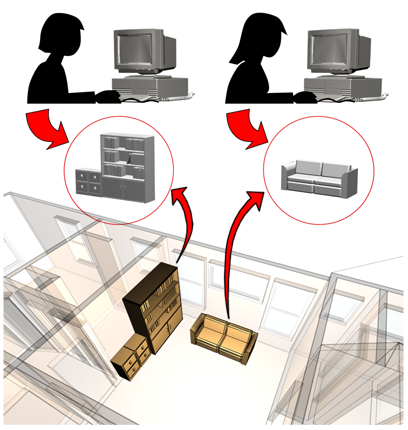You can use two kinds of externally referenced files (XRefs): XRef Objects and XRef Scenes. Using these external references allows for a team approach to animation, where the modeling, materials, transform controllers, and animation can be handled in separate files by different artists. It can also make large files much easier to deal with through the use of proxy objects.
You access the XRef Objects and XRef Scenes commands from the File menu.
The two types of references have distinct purposes:
-
An externally referenced scene displays the entire contents of an external MAX file in the current scene. The objects within the external file are visible as a reference but cannot be selected. This prevents accidental changes to the referenced scene while allowing functionality such as Snap, AutoGrid, and Clone and Align to position local objects in context, as well as to pick objects as the target location for the clones. If you need to move, rotate or scale the referenced scene, you can bind it to a local object. Transforming the object the externally referenced scene was bound to will transform all objects in the externally referenced scene. Externally referenced objects can also be used with reference coordinate systems. When changes to the externally referenced file are saved (such as objects added, edited or deleted), an Update of Xref Scene will inherit those changes locally.
- Externally referenced objects appear in the scene and can be animated. Depending on the object's XRef settings, you might or might not be able to edit the object’s entities such as its transforms, materials, manipulators, or modifiers. You can add modifiers and apply transform animation to the referenced objects, but you cannot inadvertently change the model’s structure. Referenced objects allow for the substitution of a proxy object, so you can animate a low-polygon version of a complex model and then render the polygon-intensive version.
You can also reference transform controllers externally in addition to materials. This is part of the process of referencing objects, or you can also use the special XRef controller or XRef material, respectively. By default, when referencing an object, its material and transform controller is also referenced. Alternatively, you can create an XRef controller or an XRef material that allows for referencing a transform controller or a material from an external MAX file. These external references can be assigned to any object in the scene, whether or not the object is externally referenced.
Note: Any atmospherics applied in an XRef object's source file will be carried into the scene. Render Effects assigned to XRef objects are not externally referenced.
The use of referenced objects and scenes allows several people to work collaboratively on the same objects as the work progresses, without having to wait for the objects to be finalized. You can choose to have the objects update automatically, as soon as changes are saved to the original file, or to update manually, on demand.
There are also tools for easy conversion of scene objects into referenced objects, and a button to merge referenced objects into the scene as normal objects.

Objects in a scene can be externally referenced, created and maintained by other users.